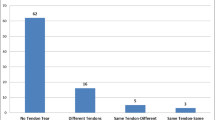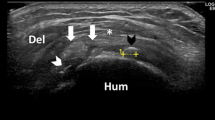Abstract
Objectives
To compare the incidence of rotator cuff (RC) tears on shoulder ultrasounds of patients with RC calcific tendinopathy (CaT) to that of a control group without CaT.
Method
In this retrospective case-control study, 50 shoulder ultrasounds of patients with CaT were compared independently by 2 musculoskeletal radiologists to 50 patients from a control group without CaT to catalog the number and type of RC tears. RC tears in the CaT group were further characterized based on location, into tears in the specific tendon(s) containing calcium versus all tendon tears.
Results
RC tears were diagnosed in 38% (19/50) of the control group (16 full-thickness) as compared to 22% (11/50) with CaT (6 full-thickness). The fewer full-thickness tears in the CaT group (12%, 6 of 50) compared to that in the control group (32%, 16 of 50) was statistically significant (P = 0.016, odds ratio 0.29). Only 7 of the 11 tears in the CaT group were in a calcium-containing tendon (3 full-thickness). The fewer calcium-containing tendon tears compared to tears in the control group was also statistically significant (P = 0.006, odds ratio 0.27). Furthermore, the fewer full-thickness calcium-containing tendon tears (6%, 3/50) compared to full-thickness tears in the control group (32%, 16/50) were yet more statistically significant (P = 0.001, odds ratio 0.14).
Conclusions
In patients with shoulder pain and CaT, we observed a decreased number of RC tears and especially calcium-containing tendon tears, as compared to similar demographic patients with shoulder pain but without CaT.
Key Points • Patients with rotator cuff calcific tendinopathy have few rotator cuff tears, especially full-thickness tears, compared to a control group without calcific tendinopathy. • The tendons containing the calcium hydroxyapatite deposition were the least likely to have a rotator cuff tear. • Future studies could evaluate if calcium hydroxyapatite deposition provides a protective mechanism against rotator cuff tears. • Musculoskeletal ultrasound is more sensitive than MRI in the evaluation of rotator cuff calcific tendinopathy. |






Similar content being viewed by others
Data availability
The authors commit to making the relevant anonymized data used and/or analyzed in the current study available on reasonable request.
Abbreviations
- CaT:
-
calcific tendinopathy
- CI95% :
-
95% confidence interval
- MRI:
-
magnetic resonance imaging
- MSK:
-
musculoskeletal
- RC:
-
rotator cuff
- US:
-
ultrasound
References
Bianchi S, Becciolini M (2019) Ultrasound appearance of the migration of tendon calcifications. J Ultrasound Med 38(9):2493–2506
Kachewar SG, Kulkarni DS (2013) Calcific tendinitis of the rotator cuff: a review. J Clin Diagn Res 7(7):1482–1485
De Carli A, Pulcinelli F, Rose GD, Pitino D, Ferretti A (2014) Calcific tendinitis of the shoulder. Joints 2(3):130–136
Jacobson JA (2018) Shoulder ultrasound. In: Jacobson JA (ed) Fundamentals of musculoskeletal ultrasound, 3rd edn. Elsevier, Philadelphia, pp 55–126
Serafini G, Sconfienza LM, Lacelli F, Silvestri E, Aliprandi A, Sardanelli F (2009) Rotator cuff calcific tendonitis: short-term and 10-year outcomes after two-needle US-guided percutaneous treatment--nonrandomized controlled trial. Radiology 252(1):157–164
ElShewy MT (2016) Calcific tendinitis of the rotator cuff. World J Orthop 7(1):55–60
Harvie P, Pollard TCB, Carr AJ (2007) Calcific tendinitis: natural history and association with endocrine disorders. J Shoulder Elbow Surg 16(2):169–173
Chiou HJ, Chou YH, Wu JJ, Hsu CC, Huang DY, Chang CY (2002) Evaluation of calcific tendonitis of the rotator cuff: role of color Doppler ultrasonography. J Ultrasound Med 21(3):289–295
Merolla G, Bhat MG, Paladini P, Porcellini G (2015) Complications of calcific tendinitis of the shoulder: a concise review. J Orthop Traumatol 16(3):175–183
Uhthoff HK, Loehr JW (1997) Calcific tendinopathy of the rotator cuff: pathogenesis, diagnosis, and management. J Am Acad Orthop Surg 5(4):183–191
Speed CA, Hazleman BL (1999) Calcific tendinitis of the shoulder. N Engl J Med 340(20):1582–1584
Beckmann NM (2016) Calcium apatite deposition disease: diagnosis and treatment. Radiol Res Pract 2016:4801474
McLaughlin HL, Asherman EG (1951) Lesions of the musculotendinous cuff of the shoulder. IV. Some observations based upon the results of surgical repair. J Bone Joint Surg Am 33A(1):76–86
Friedman MS (1957) Calcified tendinitis of the shoulder. Am J Surg 94(1):56–61
Farin PU, Jaroma H (1995) Sonographic findings of rotator cuff calcifications. J Ultrasound Med 14(1):7–14
Beckmann NM, Tran MQ, Cai C (2019) Incidence of rotator cuff tears in the setting of calcific tendinopathy on MRI: a case controlled comparison. Skeletal Radiol 48(2):245–250
Sucuoğlu H, Asan A (2020) Relationship between calcific tendinopathy and rotator cuff tear on shoulder magnetic resonance imaging: case-controlled comparison. Pol J Radiol 85:e8–e13
Hsu HC, Wu JJ, Jim YF, Chang CY, Lo WH, Yang DJ (1994) Calcific tendinitis and rotator cuff tearing: a clinical and radiographic study. J Shoulder Elbow Surg 3(3):159–164
Oliva F, Via AG, Maffulli N (2012) Physiopathology of intratendinous calcific deposition. BMC Med 10:95
Wolfgang GL (1957) Surgical repair of tears of the rotator cuff of the shoulder: factors influencing the result. J Bone Joint Surg Am 56(1):14–26
Jim YF, Hsu HC, Chang CY, Wu JJ, Chang T (1993) Coexistence of calcific tendinitis and rotator cuff tear: an arthrographic study. Skeletal Radiol 22(3):183–185
Brinkman JC, Zaw TM, Fox MG, Wilcox JG, Hattrup SJ, Chhabra A, Neville MR, Hartigan DE (2020) Calcific tendonitis of the shoulder: protector or predictor of cuff pathology? A magnetic resonance imaging-based study. Arthroscopy 36(4):983–990
Bianchi S, Martinoli C (2007) Shoulder. In: Bianchi S, Martinoli C (eds) Ultrasound of the musculoskeletal system. Springer, Berlin, pp 189–331
Lee KS (2012) Musculoskeletal sonography of the tendon. J Ultrasound Med 31(12):1879–1884
Lee KS, Rosas HG (2010) Musculoskeletal ultrasound: how to treat calcific tendinitis of the rotator cuff by ultrasound-guided single-needle lavage technique. AJR Am J Roentgenol 195(3):638
Martin-Hervas C, Romero J, Navas-Acien A, Reboiras JJ, Munuera L (2001) Ultrasonographic and magnetic resonance images of rotator cuff lesions compared with arthroscopy or open surgery findings. J Shoulder Elbow Surg 10(5):410–415
Yablon CM, Jacobson JA (2015) Rotator cuff and subacromial pathology. Semin Musculoskelet Radiol 19(3):231–242
Siegal DS, Wu JS, Newman JS, Del Cura JL, Hochman MG (2009) Calcific tendinitis: a pictorial review. Can Assoc Radiol J 60(5):263–272
Zubler C, Mengiardi B, Schmid MR, Hodler J, Jost B, Pfirrmann CWA (2007) MR arthrography in calcific tendinitis of the shoulder: diagnostic performance and pitfalls. Eur Radiol 17(6):1603–1610
Lee MH, Sheehan SE, Orwin JF, Lee KS (2016) Comprehensive shoulder US examination: a standardized approach with multimodality correlation for common shoulder disease. RadioGraphics 36(6):1606–1627
Alves TI, Girish G, Kalume Brigido M, Jacobson JA (2016) US of the knee: scanning techniques, pitfalls, and pathologic conditions. Radiographics 36(6):1759–1775
van Holsbeeck MT, Introcaso JH (eds) (2016) Musculoskeletal ultrasound, 3rd ed. Jaypee Brothers Medical Publishers, Philadelphia
Filippucci E, Delle Sedie A, Riente L, di Geso L, Carli L, Ceccarelli F, Sakellariou G, Iagnocco A, Grassi W (2013) Ultrasound imaging for the rheumatologist. XLVII. Ultrasound of the shoulder in patients with gout and calcium pyrophosphate deposition disease. Clin Exp Rheumatol 31(5):659–664
Izadpanah K, Jaeger M, Maier D, Sudkamp NP, Ogon P (2014) Preoperative planning of calcium deposit removal in calcifying tendinitis of the rotator cuff - possible contribution of computed tomography, ultrasound and conventional x-ray. BMC Musculoskelet Disord 15:385
van Holsbeeck MT, Kolowich PA, Eyler WR, Craig JG, Shirazi KK, Habra GK, Vanderschueren GM, Bouffard JA (1995) US depiction of partial-thickness tear of the rotator cuff. Radiology 197(2):443–446
Teefey SA, Rubin DA, Middleton WD, Hildebolt CF, Leibold RA, Yamaguchi K (2004) Detection and quantification of rotator cuff tears. Comparison of ultrasonographic, magnetic resonance imaging, and arthroscopic findings in seventy-one consecutive cases. J Bone Joint Surg Am 86(4):708–716
Teefey SA, Hasan SA, Middleton WD, Patel M, Wright RW, Yamaguchi K (2000) Ultrasonography of the rotator cuff. A comparison of ultrasonographic and arthroscopic findings in one hundred consecutive cases. J Bone Joint Surg Am 82(4):498–504
Wu Z, Mittal S, Kish K, Yu Y, Hu J, Haacke EM (2009) Identification of calcification with MRI using susceptibility-weighted imaging: a case study. J Magn Reson Imaging 29(1):177–182
Nörenberg D, Ebersberger HU, Walter T, Ockert B, Knobloch G, Diederichs G, Hamm B, Makowski MR (2016) Diagnosis of calcific tendonitis of the rotator cuff by using susceptibility-weighted MR imaging. Radiology 278(2):475–484
Roberts CC, Braunstein EM (2009) Crystal diseases. In: Weissman BN (ed) Imaging of arthritis and metabolic bone disease. Saunders, Philadelphia, pp 506–519
Farin PU (1996) Consistency of rotator-cuff calcifications. Observations on plain radiography, sonography, computed tomography, and at needle treatment. Invest Radiol 31(5):300–304
Acknowledgements
We thank Gordon Jacobsen, MS, Henry Ford Hospital, for his help with the statistics used in this manuscript. We also thank Stephanie Stebens, MLIS, AHIP, Henry Ford Hospital, for her editorial assistance in preparation of this manuscript.
Author information
Authors and Affiliations
Contributions
NCL, KAR, AT, and JRL interpreted data, contributed to the discussion and design of the study, and reviewed/edited the manuscript. CLK researched and interpreted data, contributed to the discussion and design of the study, and reviewed/edited the manuscript. SBS researched and interpreted data, contributed to the discussion and design of the study, and wrote the manuscript.
Corresponding author
Ethics declarations
Disclosures
None.
Ethics approval and consent to participate
All procedures performed in studies involving human participants were in accordance with the ethical standards of the institutional and/or national research committee and with the 1964 Declaration of Helsinki and its later amendments or comparable ethical standards. Institutional review board approval was obtained (IRB # 12367, July 13, 2018) and informed consent was waived. Our study complied with the Health Insurance Portability and Accountability Act.
Consent for publication
We consent to publication.
Code availability
Not applicable
Additional information
Publisher’s note
Springer Nature remains neutral with regard to jurisdictional claims in published maps and institutional affiliations.
Rights and permissions
About this article
Cite this article
Laucis, N.C., Rosen, K.A., Thodge, A. et al. Sonographic evaluation of the association between calcific tendinopathy and rotator cuff tear: a case-controlled comparison. Clin Rheumatol 40, 2897–2905 (2021). https://doi.org/10.1007/s10067-021-05597-8
Received:
Revised:
Accepted:
Published:
Issue Date:
DOI: https://doi.org/10.1007/s10067-021-05597-8




